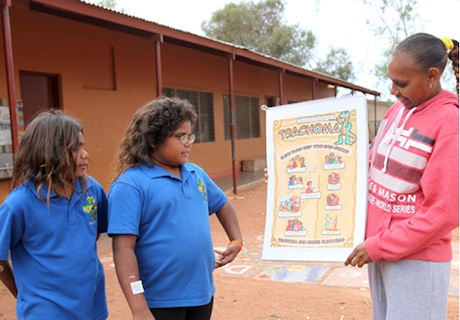Project Overview
Trachoma is a severely painful disease and the largest infectious cause of blindness in the world. Australia remains the only developed country where trachoma still exists.
This project aims to eliminate trachoma in Indigenous communities through a treatment strategy called S.A.F.E: Surgery, Antibiotics, Face washing, Environment.
In 2012, The Fred Hollows Foundation funded the employment and training of 14 Aboriginal Community Based Workers to support the Australian Government's Trachoma Elimination Program in nine remote communities across the Northern Territory.
Community Based Workers play a critical role in reducing trachoma rates. They encourage participation in trachoma screening and treatment. They increase uptake of face washing amongst children.
Project success
In Ntaria (Hermannsburg), one of the communities targeted in the project, data from the Centre for Disease Control shows that in 2010 prevalence of trachoma in five to nine year olds was 43 per cent. In 2012 this figure had dropped to five per cent.
Case Study - Meet Thelma, an Aboriginal Community Based Worker
Meet Thelma, 23, a mother of two who is helping eliminate trachoma in the community of Ntaria (Hermannsburg) as a Foundation-supported Aboriginal Community Based Worker.
Thelma now plays a critical role in educating her community about trachoma and encouraging good eye health habits.
Thelma connects people in the Ntaria community with eye nurses and other health workers who can provide trachoma treatment. She is able to educate people on eye health in a culturally appropriate way. Strategies include having eye health materials approved by community elders and translated into their Arrernte language to ensure local understandings of trachoma and how to prevent the disease.
The knowledge Thelma shares is leading to behavioural change in her community, which is the key to preventing trachoma reinfection in the future.

Photo: Thelma teaching students about trachoma.
Reaching children is a priority. During a recent mass trachoma treatment and screening at the local school, Thelma worked with nurses to explain the purpose of trachoma antibiotics and teach positive eye health messages.
“I teach the kids to wash their hands and nose and keep their faces clean so they have good eyes and don’t go blind when they get older," says Thelma.
“I like to help the kids and the young ones so when they grow up they can help their own children,” Thelma says.
Thelma feels positive about the future eye health of people in her community. One day she would like to train as a nurse so she can do even more to help children.
“I’m hoping my two girls do as I’m doing now when they grow up – finish school and work in the community,” she says.
What's next?
Footprints is continuing to provide funds though out 2013 for this large scale Trachoma Elimination project to increase the number of Indigenous Australians being screened and treated for trachoma. See more
The project aim:
To eliminate trachoma in 10 Indigenous communities in the Northern Territory
Project objectives
- Increase the number of Indigenous Australians being screened and treated for trachoma
- Support community-based workers to take part in implementing components of SAFE programs
- Increase community awareness and implementation of good hygiene practices
- Work
with government to ensure environmental improvements are made where
necessary in affected communities, to ensure the sustainability of SAFE
strategies
Background on this issue:
Trachoma is a
highly infectious, severely painful disease. It is the largest
infectious cause of blindness in the world with around 4.6 million
people in advanced stages of the disease. Over time a person’s eyelids
become scarred and the eyelashes turn inwards, rubbing on the cornea and
ultimately causing blindness.
There is good news however – it is
preventable and treatable. The Fred Hollows Foundation works to
eliminate trachoma through a World Health Organisation treatment
strategy called S.A.F.E: Surgery, Antibiotics, Face washing,
Environment..
Australia is the only developed country in the world
where trachoma remains endemic. It is still present in two thirds of
remote communities in the Northern Territory, Western Australia and
South Australia.

Project partners
Developed
in collaboration with the Northern Territory Government’s Centre for
Disease Control and the University of Melbourne Indigenous Eye Health
Unit, the program will be implemented in partnership with these agencies
and managed by The Fred Hollows Foundation.